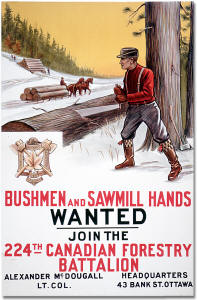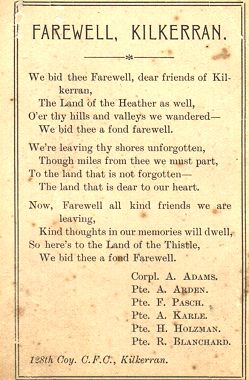Canadian Forestry Corps. From Wikipedia, the free encyclopedia
 The
Canadian Forestry Corps was an
administrative corps of the Canadian
Army. It was created during the First
World War when it was discovered that
huge quantities of wood were needed for
use on the Western Front. Duckboards,
shoring timbers, crates -- anything that
needed wood had to be provided. The
British government concluded that there
was nobody more experienced or qualified
in the British Empire to harvest timber
than the Canadians. At first the idea
was to harvest the trees from Canada's
abundant forests and bring them
overseas. But space aboard merchant
ships was at a premium, so rather than
stuff ships' holds with timber, it was
decided to use the Canadians over in
Europe, cutting down forests in the UK
and France.
The
Canadian Forestry Corps was an
administrative corps of the Canadian
Army. It was created during the First
World War when it was discovered that
huge quantities of wood were needed for
use on the Western Front. Duckboards,
shoring timbers, crates -- anything that
needed wood had to be provided. The
British government concluded that there
was nobody more experienced or qualified
in the British Empire to harvest timber
than the Canadians. At first the idea
was to harvest the trees from Canada's
abundant forests and bring them
overseas. But space aboard merchant
ships was at a premium, so rather than
stuff ships' holds with timber, it was
decided to use the Canadians over in
Europe, cutting down forests in the UK
and France.
Several regiments originally slated for the front lines became military lumberjack units instead. Canadian troops with their coniferous-tree cap badges identifying them as the Canadian Forestry Corps cut trees in forests in England, Scotland and France, where the timber was squared, sawed and transported. The CFC also built aerodromes in France for the ever-burgeoning Royal Flying Corps.
Although individual troops in emergency situations were sent to fight on the front lines the CFC usually served well back of the fighting.
Towards the final two years of the war, more and more Canadian soldiers volunteered for the Forestry Corps, as it was viewed by many as a way to serve the country without facing the German Army in direct conflict. The Corps was not without casualties however, accidents like those which would occur in a forestry camp in Canada were not uncommon: power saws, machinery and transport all took lives.
The Corps was later disbanded although brought back for service in the Second World War. The Canadian National War Memorial in Ottawa has a statue figure of a member of the Canadian Forestry Corps upon it near the back of the memorial. The CFC is largely forgotten today but played an important role in the eventual Allied victory in World War 1.

